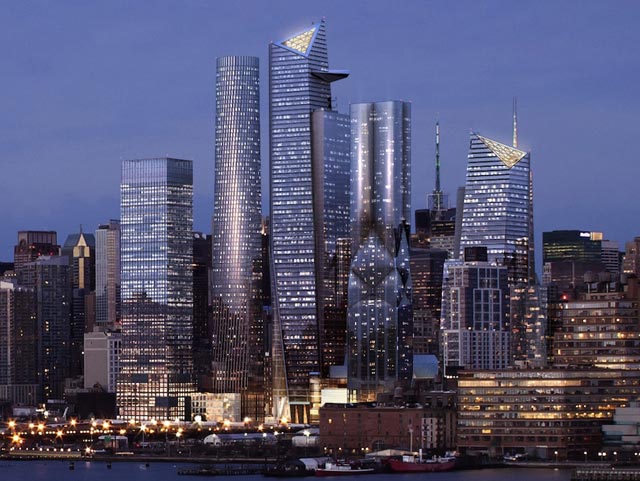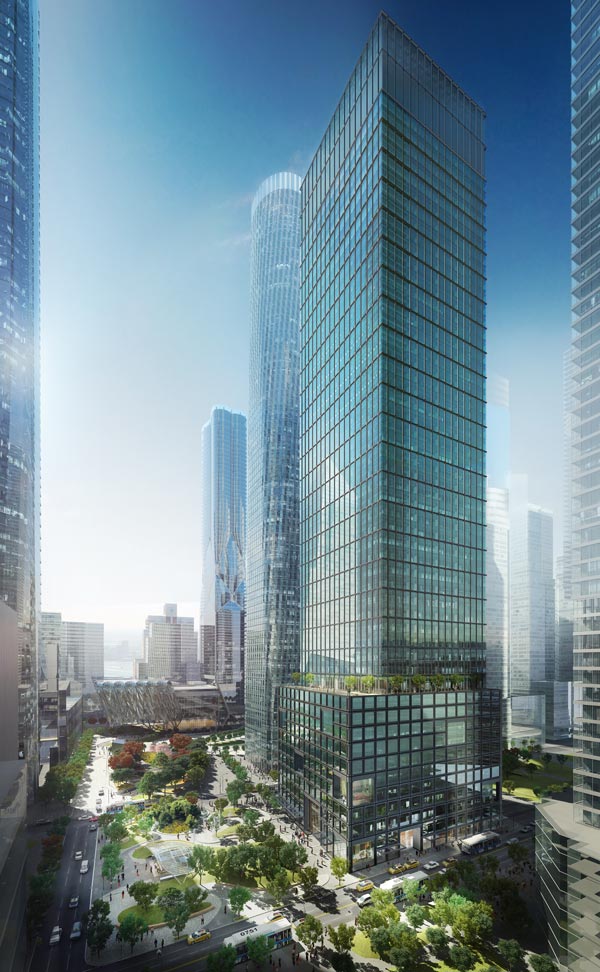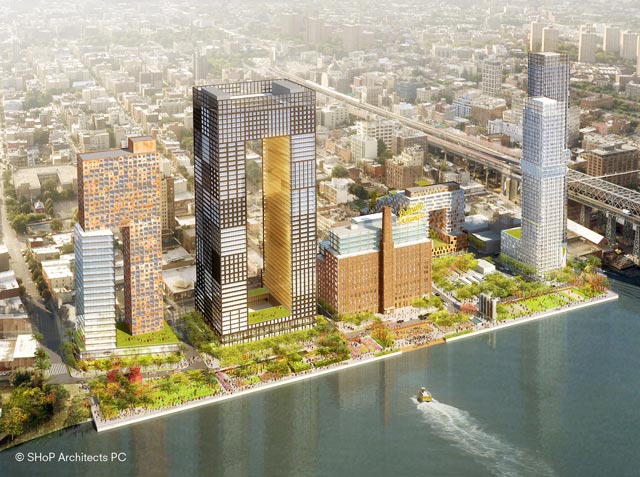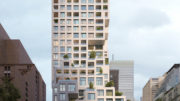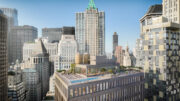A slew of super-sized office buildings are set to rise in Manhattan over the next several years, punctuating the city’s skyline with new spires of glass. Towers with over 10 million square feet of class A space – at the World Trade Center, Hudson Yards and Midtown proper – are either under construction or looking for tenants and financing.
With tenants lined up at for the first two office buildings at Hudson Yards and nearly half of the space committed at One and Four World Trade Center, these glittering giants are going for the globe’s elite corporations. Marquee tenants desire marquee buildings. Ten million square feet of Class A office space is set to rise in New York in the next few years, most of it underwritten by billions of dollars of public investments and tax abatements.
But as much as the city’s future competitiveness rests with satisfying the office needs of Fortune 500 companies, it also depends on attracting and nurturing startups in high-growth industries like tech, media, and design. These firms require a different sort of office space, and they’re finding it in less traditional buildings outside of Midtown’s office district.
There is rising concern that the city will not have enough flexible office space that meets the needs of startups, tech firms and creative businesses. City officials hope that it is these types of businesses that will propel the city’s economy through the 21st century, just as finance did during the second half of the twentieth.
These firms tend to shun the corporate Class A tower for more flexible spaces in Class B and Class C buildings. They are seeking space in Chelsea, Midtown South, Downtown, and Brooklyn, most often in pre-war buildings that are often cheaper and better suited to layouts preferred by high-growth industries.
“Tech companies are finding characteristics in pre-war buildings that they’re not finding in new office buildings,” says Vishaan Chakrabarti of SHoP Architects and Columbia University’s Center for Urban Real Estate. He notes that 85 percent of new, young companies are in older, pre-war buildings rather than Class A office towers.
Part of the reason is based on economics, but the preference for pre-war also reflects deeper changes in workplace culture: an aversion of the corporate aesthetic, an emphasis on collaboration, and a blurring of the lines between one’s “work life” and “social life.”
Tech and creative firms value collaboration, something that does not happen in sequestered offices on separate floors. Collaboration takes place in shared spaces, co-working stations, and other spaces intended to maximize “casual collisions of the workforce.” Pre-war buildings provide the opportunity to accommodate these arrangements in a way that is often difficult or impossible in corporate towers.
The preference for more collaborative spaces reflects foundational and long-lasting changes in the way people delineate their work lives from their social lives. It also reflects how the boundaries of the “workspace” have expanded to include our homes, our commutes, the café, and the park. It is no longer necessary to stay at one’s desk in order to work.
The workspace is now spilling out of office buildings and into neighboring parks, cafés, and even beer halls. As a result, neighborhoods matter, and young firms want 24-hour neighborhoods where jobs and housing are mixed together with restaurants, bars, and nightlife.
This type of working arrangement started with tech companies, but as Chakrabarti notes, “The reality is that most new young companies are tech companies,” including those in architecture. “I’d consider SHoP a tech company.” The upshot is that these new workplaces will become the new normal.
The move towards shared spaces means that companies need fewer square feet per worker than traditional office layouts. It also means that the single-purpose office district will become increasingly unattractive to newer firms.
Growth in creative and technology firms is outpacing that in finance, and developers of Class A space may be beginning to get the message. As the website for 55 Hudson Yards proclaims, the building will feature “efficient and flexible workspace” for “a work/life integration that enhances employee performance.” 10 Hudson Yards will bridge over the High Line Park with a 60-foot public passageway through the building. One can imagine employees at Coach or L’Oreal bringing their laptops down to the park to collaborate on a new project.
But this space will surely be too expensive for the smaller firms that make up another important pillar of the city’s economy. There is an emerging consensus that the city’s focus must shift to growing the supply of Class B and C office space. The city actually lost 6.2 million square feet of Class B and C space since 2000, even as demand has heated up. The city’s Economic Development Corporation estimates that all the remaining space will be full by 2018. If more space doesn’t become available, the city risks missing out on the next wave of high-growth firms.
Seth Pinsky, former president of the city’s Economic Develoment Corporation and now with RXR Realty, recently said, “There needs to be affordable space for the small companies and start-ups we talk so much about attracting to the city,” noting that up to 15 million square feet of affordable space may be lost in the coming years.
And while some of this growth will happen in Manhattan, policymakers and developers are increasingly focusing on the Brooklyn-Queens waterfront for new job growth. While a developer needs at least $67/square foot to break even on a new development in Midtown South, only $46/square foot is needed in Downtown Brooklyn and Long Island City, according to the EDC.
Bellwethers include the Watchtower properties, with 1.3 million square feet of space, and the New Domino development’s 500,000 square feet of office space. Smaller conversions like 1000 Dean Street and 29 Ryerson Street, both in Brooklyn, will also be a critical component of any strategy to grow space for startups and creative firms.
The de Blasio administration is also rethinking the role of industrial zones along the Brooklyn-Queens waterfront. Planning commission chair Carl Weisbrod recently talked of industrial zones in Long Island City, musing whether “the city can manufacture space by going vertical for industrial use, allowing businesses to expand.” His idea of vertical manufacturing spaces sounds a bit like the type of space favored by tech and creative startups.
The challenge is that Class B and C office space often doesn’t command the rents necessary to cover the cost of adaptive redevelopment, not to mention new construction. “We get the sense that the marketplace is struggling to build new office space for these newer kinds of companies,” says Chakrabarti.
He suggests that the city step in to provide assistance to property owners in older commercial buildings to upgrade their facilities and broadband access. “There needs to be a new type of building, a ‘Class T’ building that gets away from the A, B, C classification.”
Others warn about losing valuable commercial space to residential use. The EDC predicts that another 12 million square feet of Class B and C space will be lost to residential conversions in the next 12 years. There is also talk that the de Blasio administration is considering whether housing should be allowed in the city’s industrial zones.
Jonathan Bowles of the Center for an Urban Future commented on Long Island City’s industrial zones, “I think that we ought to be looking; should that be preserved, tech companies in the next few years may be able to go there—or creative businesses.”
While the city must ensure that construction, transportation, and warehousing firms have a space in the city, there are definitely places where housing and jobs can coexist. Chakrabarti explains, “This isn’t just about housing, it’s about the ecology of people’s lives. We want to start building these communities where people can walk to work or bike to work.”
This was central to the plan at New Domino, and “At Domino, there’s an intent to build the ecology of an entire neighborhood.” (The fact that local politicians would more readily accept a density boost if it came in the form of office space probably didn’t hurt either.)
The city should also consider the live/work approach when reevaluating its plans for Midtown East. Both commercial and residential space should be included in new buildings, with a higher allowable density to ensure that enough new office space is still built. Conversions should not necessarily be discouraged, as more residents and uses would breathe new life into the neighborhood, with the Financial District offering a prime example of resurgent vitality due to similar conditions.
Housing is also a vital component at Hudson Yards, as is the pedestrian environment. The more employees arriving by bike or via The High Line, the more successful the neighborhood will be.
As the nature of the office market changes—preferences, workplace culture, the blurred lines between the office and the surrounding neighborhood—developers and policymakers must react. By focusing on growing startup-friendly buildings—especially in Brooklyn and Queens—the city can work to replace the exodus of manufacturing employment. And by rethinking established office districts as opportunities for additional residential development, the city can meet the needs of tomorrow’s high-growth firms.
For any questions, comments, or feedback, email [email protected]
Subscribe to YIMBY’s daily e-mail
Follow YIMBYgram for real-time photo updates
Like YIMBY on Facebook
Follow YIMBY’s Twitter for the latest in YIMBYnews

